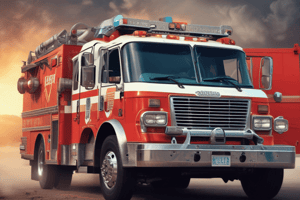Podcast
Questions and Answers
What is a critical aspect of a crew member's responsibility?
What is a critical aspect of a crew member's responsibility?
- Performing regular vehicle inspections only once a week
- Ensuring the unit is capable of responding to a call and has proper equipment and supplies (correct)
- Driving the vehicle to the nearest gas station to refuel
- Responding to a call as quickly as possible
What should a crew member do if they notice issues with the vehicle's 'four S's'?
What should a crew member do if they notice issues with the vehicle's 'four S's'?
- Try to fix the issue themselves
- Drive the vehicle to the nearest mechanic
- Continue to use the vehicle and hope the issue resolves itself
- Put the vehicle out of service (correct)
What is a common indication of a pending problem with the vehicle?
What is a common indication of a pending problem with the vehicle?
- A full tank of fuel
- A clean and organized interior
- Belt noise or loss of fluid (correct)
- A newly washed exterior
What is a key aspect of regular vehicle inspections?
What is a key aspect of regular vehicle inspections?
What can affect the vehicle's ability to respond to a call?
What can affect the vehicle's ability to respond to a call?
What is a common feature of modern emergency vehicles?
What is a common feature of modern emergency vehicles?
What is a significant responsibility for emergency vehicle drivers?
What is a significant responsibility for emergency vehicle drivers?
Who developed guidelines for emergency medical transport vehicles in the 1970s?
Who developed guidelines for emergency medical transport vehicles in the 1970s?
What type of emergency vehicle has a modular body that can be transferred to a newer chassis?
What type of emergency vehicle has a modular body that can be transferred to a newer chassis?
What is a feature of specialized emergency medical units?
What is a feature of specialized emergency medical units?
Why are spaces on an emergency vehicle designed for storing and securing equipment?
Why are spaces on an emergency vehicle designed for storing and securing equipment?
Who influences the list of supplies and equipment carried on emergency vehicles?
Who influences the list of supplies and equipment carried on emergency vehicles?
What improvement has been made to emergency vehicles?
What improvement has been made to emergency vehicles?
Flashcards are hidden until you start studying
Study Notes
Emergency Vehicle Technology
- Modern emergency vehicles are equipped with state-of-the-art technology, including defibrillators, monitors, and GPS systems.
- These vehicles are also equipped with data recording systems that track speed, braking, and other movements.
- Patient loading systems with stretchers and mobile data terminals are also common features.
Driver Responsibility
- Driving an emergency vehicle is a significant responsibility, requiring awareness of safety for the crew, passengers, and other vehicles on the road.
- Activating lights and sirens does not guarantee right-of-way or understanding from other drivers.
Vehicle Design and Standards
- The US General Services Administration (GSA) developed guidelines for emergency medical transport vehicles in the 1970s.
- The GSA guidelines are reviewed and updated every 5 years and are used by many states to qualify for government grant funding.
- Two specifications, NFPA and CAAS, are being considered as replacements to the GSA guidelines.
Major Emergency Medical Vehicle Designs
- Type 1: Conventional truck cab chassis with a modular body that can be transferred to a newer chassis.
- Type 2: Standard van with a modular body that allows for movement between the front and back.
- Type 3: Specialty van with a modular body that allows for movement between the front and back and can be transferred to a new chassis.
Improvements and Specialized Units
- Improvements made to emergency vehicles include enlargement of the patient compartment, safety nets, and padded corners.
- Specialized units, such as mobile stroke units and pediatric mobile intensive units, are staffed by specialized teams and equipped with advanced technology.
Equipment and Supplies
- Every inch of space on an emergency vehicle is designed for storing and securing equipment.
- Organizations such as OSHA and the American College of Surgeons influence the list of supplies and equipment carried on emergency vehicles.
- Crew members are responsible for ensuring that the unit is capable of responding to a call and that the proper equipment and supplies are available.
Vehicle Inspection and Maintenance
- Crew members are responsible for checking and maintaining equipment and supplies before each call.
- Regular inspections should include checking fuel, oil, and other fluid levels, as well as belts, tires, and interior and exterior lights.
- Any issues with the vehicle's "four S's" (starting, steering, stopping, and staying running) should prompt the operator to put the vehicle out of service.
Warning Signs of Pending Problems
- Belt noise, brake fade, brake pull, and loss of fluid can indicate pending problems with the vehicle.
- Drifting, steering pull, pulsating brake pedals, steering play, tire squeal, wheel wobble, and other issues can affect the vehicle's ability to respond to a call.
Emergency Vehicle Technology
- Modern emergency vehicles are equipped with advanced technology, including defibrillators, monitors, and GPS systems, to provide efficient emergency services.
- Data recording systems track speed, braking, and other movements, enabling data-driven improvements.
Driver Responsibility
- Driving an emergency vehicle requires awareness of safety for the crew, passengers, and other vehicles on the road, as activating lights and sirens does not guarantee right-of-way.
Vehicle Design and Standards
- The US General Services Administration (GSA) developed guidelines for emergency medical transport vehicles in the 1970s, which are reviewed and updated every 5 years.
- The GSA guidelines are used by many states to qualify for government grant funding, with NFPA and CAAS specifications being considered as replacements.
Major Emergency Medical Vehicle Designs
- Type 1 design features a conventional truck cab chassis with a modular body that can be transferred to a newer chassis.
- Type 2 design features a standard van with a modular body that allows for movement between the front and back.
- Type 3 design features a specialty van with a modular body that allows for movement between the front and back and can be transferred to a new chassis.
Improvements and Specialized Units
- Improvements to emergency vehicles include enlarging the patient compartment, adding safety nets, and padding corners.
- Specialized units, such as mobile stroke units and pediatric mobile intensive units, are staffed by specialized teams and equipped with advanced technology.
Equipment and Supplies
- Every inch of space on an emergency vehicle is designed for storing and securing equipment.
- Organizations like OSHA and the American College of Surgeons influence the list of supplies and equipment carried on emergency vehicles.
Vehicle Inspection and Maintenance
- Crew members are responsible for checking and maintaining equipment and supplies before each call.
- Regular inspections should include checking fuel, oil, and other fluid levels, as well as belts, tires, and interior and exterior lights.
- Any issues with the vehicle's "four S's" (starting, steering, stopping, and staying running) should prompt the operator to put the vehicle out of service.
Warning Signs of Pending Problems
- Belt noise, brake fade, brake pull, and loss of fluid can indicate pending problems with the vehicle.
- Issues like drifting, steering pull, pulsating brake pedals, steering play, tire squeal, wheel wobble, and others can affect the vehicle's ability to respond to a call.
Studying That Suits You
Use AI to generate personalized quizzes and flashcards to suit your learning preferences.




